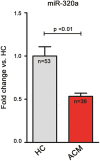MiR-320a as a Potential Novel Circulating Biomarker of Arrhythmogenic CardioMyopathy
- PMID: 28684747
- PMCID: PMC5500514
- DOI: 10.1038/s41598-017-05001-z
MiR-320a as a Potential Novel Circulating Biomarker of Arrhythmogenic CardioMyopathy
Abstract
Diagnosis of Arrhythmogenic CardioMyopathy (ACM) is challenging and often late after disease onset. No circulating biomarkers are available to date. Given their involvement in several cardiovascular diseases, plasma microRNAs warranted investigation as potential non-invasive diagnostic tools in ACM. We sought to identify circulating microRNAs differentially expressed in ACM with respect to Healthy Controls (HC) and Idiopathic Ventricular Tachycardia patients (IVT), often in differential diagnosis. ACM and HC subjects were screened for plasmatic expression of 377 microRNAs and validation was performed in 36 ACM, 53 HC, 21 IVT. Variable importance in data partition was estimated through Random Forest analysis and accuracy by Receiver Operating Curves. Plasmatic miR-320a showed 0.53 ± 0.04 fold expression difference in ACM vs. HC (p < 0.01). A similar trend was observed when comparing ACM (n = 13) and HC (n = 17) with athletic lifestyle, a ACM precipitating factor. Importantly, ACM patients miR-320a showed 0.78 ± 0.05 fold expression change vs. IVT (p = 0.03). When compared to non-invasive ACM diagnostic parameters, miR-320a ranked highly in discriminating ACM vs. IVT and it increased their accuracy. Finally, miR-320a expression did not correlate with ACM severity. Our data suggest that miR-320a may be considered a novel potential biomarker of ACM, specifically useful in ACM vs. IVT differentiation.
Conflict of interest statement
The authors declare that they have no competing interests.
Figures





References
Publication types
MeSH terms
Substances
LinkOut - more resources
Full Text Sources
Other Literature Sources

